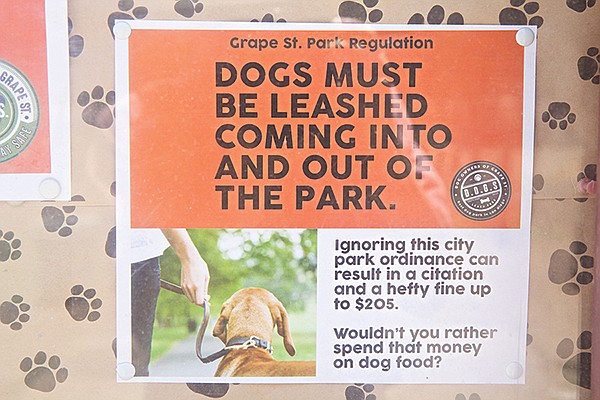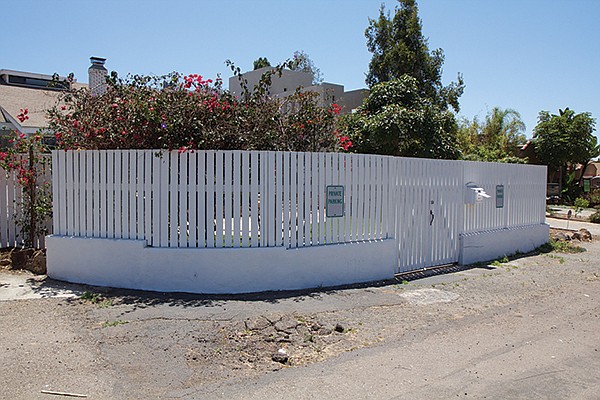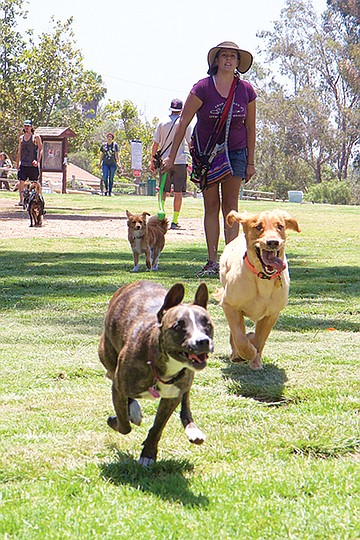 Facebook
Facebook
 X
X
 Instagram
Instagram
 TikTok
TikTok
 Youtube
Youtube

A failed plea to city officials to install a new fence to enclose the Grape Street off-leash dog park in South Park led to a crackdown that resulted in more than two dozen dog-owners receiving tickets from San Diego police and park rangers in late April and early May. Currently, the park has partial fencing, with a high chain-link backing the golf course driving range on its western border and a low post and rail along the eastern entrance. The eastern fence is at issue, as the porous, ungated fence does not contain animals from leaving the park to access the parking lot and street and the row of private residences across the street from the park.


A February 16th email sent by the owner of one those homes started it off. Addressed to the offices of councilman Todd Gloria, mayor Kevin Faulconer, and city attorney Jan Goldsmith, plus Park and Recreation Department officials and a dozen fellow neighbors, it read in part: “We would like to request your assistance to install a low rise type fence…around the perimeter of the park.”
Citing repeated violations by park visitors over the past two decades, it went on to ask for enforcement of rules posted at the dog-park entrance, particularly those designating off-leash boundaries and off-leash hours (7:30 a.m.–9 p.m. weekdays, 9 a.m.–9 p.m. weekends and holidays).
Subsequent emails from other park neighbors within the thread described off-leash dogs entering private property to defecate, chase cats, or flee other dogs from within the park. One neighbor submitted a photograph claiming to depict dog owners visiting the park at 6:30 a.m. Another wrote: “I cannot count the times we are awoken from sleep with dog owners arriving well before the posted hours.” This homeowner also attached copies of similar letters sent to city officials dating back to 2010 as evidence this problem has been ongoing, and reported, for several years.
A representative of Todd Gloria’s office responded quickly, asking the Park and Recreation Department to obtain an estimate of what a new, gated fence would cost, and suggesting one might be funded by the department, or District 3’s Community Projects, Programs, and Services funding. A roughly $30,000 quote was obtained, based on a previously proposed 2003 plan that would install a fence containing the eastern and southern borders of the park, with separate gates for dogs and park custodial equipment. Around the same time, police and park rangers covering the jurisdiction were instructed to “conduct security checks in the park when time permits and enforce appropriate violations when warranted.”
It’s unclear whether any citations were issued for park violations during this time. Asked to provide this data, a San Diego Police Department representative said, “Dog-related citations are not records we compile as a regular course of business.”
However, in mid-March, several other South Park residents and self-described dog-park users and volunteers wrote Gloria’s office in opposition to a new fence, claiming it “could destroy the natural beauty to fence the entire park,” or that “the proposed fence will not solve the problem and would be an unwarranted expense.” This thread of emails also suggested enforcement would be more effective, that a “greater emphasis on having owners leash animals upon entering and leaving the park, to include fines, would result in greater safety for the dogs using the park.”
While the fence was discussed in committee meetings, differing viewpoints as to whether it was necessary and which sections of the park it should contain led to stalled efforts and no funding. Gloria’s office reports, “There was not a clear consensus on the type of fencing that would best address the issue, and we did not believe our limited [community projects] funds could cover the costs.” However, after being told on February 17th that Gloria’s office would work to “identify funds” for a new fence, the dog park’s immediate neighbors remained uninformed of any decision to stop pursuing this plan.
So, on April 16 another dog-park neighbor wrote a more strongly worded email addressed to city police officials: “I’m writing to find out what progress has been made by the city and city officials to properly fence and enforce the off leash hours?”
Central Division police captain Chuck Kaye responded by paying a visit to the park one morning in April. “I saw exactly what was described in the email,” he says, including dogs running into residents’ yards and owners otherwise disregarding the posted rules. Kaye says he spoke to several dog owners about the rules, and while most responded civilly to the uniformed officer, he says, “A small number were kind of offended.” A witness contends at least one of these individuals actually lost his temper when confronted by Kaye.
Park neighbors say this sort of response is nothing new. Speaking on condition of anonymity, nine residents of homes facing the park along 28th Street and the immediately adjacent block of Grape Street came together to speak about the issues, which include the cars of park visitors blocking their driveways, off-leash dogs entering their properties and behaving in a threatening manner, and dog owners entering yards and even homes unannounced in search of their pets. Several of these neighbors claim verbal abuse is the typical response whenever they ask dog owners for consideration of their property and privacy.

“We used to remind people nicely and politely,” says a resident when describing interactions with park visitors. “More often than not we’d get yelled at, we’d get screamed at.” Another says it sometimes goes further: “If you take a stand, sometimes things happen to your house…. We’ve had things stolen from our yard, and I’ve been harassed in the neighborhood.”
Other accounts describe property damage caused by cars leaving the park. At least two neighbors recount parked vehicles being hit. Other residents have paid as much as $2500 to erect fences in an effort to keep untended dogs and uncurbed dog poop out of their yards. On multiple occasions, cars leaving the park have smashed into one of these fences, once within weeks of it being built. All of these incidents involved hit-and-run drivers, the property owners said.
If the residents do happen to be present to confront a dog-owner, they say they’re usually met with the response, “If you don’t like it, you should just move.” However, many of the homeowners have lived here for longer than the park has been designated off-leash. Most of them do not wish to see the dog park taken away from the community, but they would like the city to protect them from the daily violations of rules partly intended to shield them from the more than 1000 park visitors per day, 365 days per year.
“The majority of the people who use the park are responsible dog-owners,” one of the park neighbors points out, “but unfortunately the ones that are not responsible are repeat offenders.” All eight of the other residents corroborate the consistency of rules violations, expressing a frustration that even a few minor incidents per day becomes compounded by the constancy of them over more than 15 years, and that they often feel left by the city to bear the brunt of it.
Following the visit by Captain Kaye, police officers and rangers patrolling the area began issuing citations, including the use of unmarked patrol cars and officers patrolling Balboa Park on ATVs. Several mornings, officers have been present to turn away dog-owners attempting to access the park prior to off-leash hours. Beginning with an April 22nd coordinated sting during which 12 tickets were issued, 26 citations were handed out within three weeks, frustrating many park visitors who claim they’re being collectively and indiscriminately punished for the actions of a small minority of irresponsible dog owners.
“The only way to solve the problem is to target the individuals that are being disruptive, not everybody,” one regular park visitor says. Another posted to a neighborhood social media site, “People who let their dogs run off-leash in undesignated areas really ruin it for the rest of us.”


A failed plea to city officials to install a new fence to enclose the Grape Street off-leash dog park in South Park led to a crackdown that resulted in more than two dozen dog-owners receiving tickets from San Diego police and park rangers in late April and early May. Currently, the park has partial fencing, with a high chain-link backing the golf course driving range on its western border and a low post and rail along the eastern entrance. The eastern fence is at issue, as the porous, ungated fence does not contain animals from leaving the park to access the parking lot and street and the row of private residences across the street from the park.


A February 16th email sent by the owner of one those homes started it off. Addressed to the offices of councilman Todd Gloria, mayor Kevin Faulconer, and city attorney Jan Goldsmith, plus Park and Recreation Department officials and a dozen fellow neighbors, it read in part: “We would like to request your assistance to install a low rise type fence…around the perimeter of the park.”
Citing repeated violations by park visitors over the past two decades, it went on to ask for enforcement of rules posted at the dog-park entrance, particularly those designating off-leash boundaries and off-leash hours (7:30 a.m.–9 p.m. weekdays, 9 a.m.–9 p.m. weekends and holidays).
Subsequent emails from other park neighbors within the thread described off-leash dogs entering private property to defecate, chase cats, or flee other dogs from within the park. One neighbor submitted a photograph claiming to depict dog owners visiting the park at 6:30 a.m. Another wrote: “I cannot count the times we are awoken from sleep with dog owners arriving well before the posted hours.” This homeowner also attached copies of similar letters sent to city officials dating back to 2010 as evidence this problem has been ongoing, and reported, for several years.
A representative of Todd Gloria’s office responded quickly, asking the Park and Recreation Department to obtain an estimate of what a new, gated fence would cost, and suggesting one might be funded by the department, or District 3’s Community Projects, Programs, and Services funding. A roughly $30,000 quote was obtained, based on a previously proposed 2003 plan that would install a fence containing the eastern and southern borders of the park, with separate gates for dogs and park custodial equipment. Around the same time, police and park rangers covering the jurisdiction were instructed to “conduct security checks in the park when time permits and enforce appropriate violations when warranted.”
It’s unclear whether any citations were issued for park violations during this time. Asked to provide this data, a San Diego Police Department representative said, “Dog-related citations are not records we compile as a regular course of business.”
However, in mid-March, several other South Park residents and self-described dog-park users and volunteers wrote Gloria’s office in opposition to a new fence, claiming it “could destroy the natural beauty to fence the entire park,” or that “the proposed fence will not solve the problem and would be an unwarranted expense.” This thread of emails also suggested enforcement would be more effective, that a “greater emphasis on having owners leash animals upon entering and leaving the park, to include fines, would result in greater safety for the dogs using the park.”
While the fence was discussed in committee meetings, differing viewpoints as to whether it was necessary and which sections of the park it should contain led to stalled efforts and no funding. Gloria’s office reports, “There was not a clear consensus on the type of fencing that would best address the issue, and we did not believe our limited [community projects] funds could cover the costs.” However, after being told on February 17th that Gloria’s office would work to “identify funds” for a new fence, the dog park’s immediate neighbors remained uninformed of any decision to stop pursuing this plan.
So, on April 16 another dog-park neighbor wrote a more strongly worded email addressed to city police officials: “I’m writing to find out what progress has been made by the city and city officials to properly fence and enforce the off leash hours?”
Central Division police captain Chuck Kaye responded by paying a visit to the park one morning in April. “I saw exactly what was described in the email,” he says, including dogs running into residents’ yards and owners otherwise disregarding the posted rules. Kaye says he spoke to several dog owners about the rules, and while most responded civilly to the uniformed officer, he says, “A small number were kind of offended.” A witness contends at least one of these individuals actually lost his temper when confronted by Kaye.
Park neighbors say this sort of response is nothing new. Speaking on condition of anonymity, nine residents of homes facing the park along 28th Street and the immediately adjacent block of Grape Street came together to speak about the issues, which include the cars of park visitors blocking their driveways, off-leash dogs entering their properties and behaving in a threatening manner, and dog owners entering yards and even homes unannounced in search of their pets. Several of these neighbors claim verbal abuse is the typical response whenever they ask dog owners for consideration of their property and privacy.

“We used to remind people nicely and politely,” says a resident when describing interactions with park visitors. “More often than not we’d get yelled at, we’d get screamed at.” Another says it sometimes goes further: “If you take a stand, sometimes things happen to your house…. We’ve had things stolen from our yard, and I’ve been harassed in the neighborhood.”
Other accounts describe property damage caused by cars leaving the park. At least two neighbors recount parked vehicles being hit. Other residents have paid as much as $2500 to erect fences in an effort to keep untended dogs and uncurbed dog poop out of their yards. On multiple occasions, cars leaving the park have smashed into one of these fences, once within weeks of it being built. All of these incidents involved hit-and-run drivers, the property owners said.
If the residents do happen to be present to confront a dog-owner, they say they’re usually met with the response, “If you don’t like it, you should just move.” However, many of the homeowners have lived here for longer than the park has been designated off-leash. Most of them do not wish to see the dog park taken away from the community, but they would like the city to protect them from the daily violations of rules partly intended to shield them from the more than 1000 park visitors per day, 365 days per year.
“The majority of the people who use the park are responsible dog-owners,” one of the park neighbors points out, “but unfortunately the ones that are not responsible are repeat offenders.” All eight of the other residents corroborate the consistency of rules violations, expressing a frustration that even a few minor incidents per day becomes compounded by the constancy of them over more than 15 years, and that they often feel left by the city to bear the brunt of it.
Following the visit by Captain Kaye, police officers and rangers patrolling the area began issuing citations, including the use of unmarked patrol cars and officers patrolling Balboa Park on ATVs. Several mornings, officers have been present to turn away dog-owners attempting to access the park prior to off-leash hours. Beginning with an April 22nd coordinated sting during which 12 tickets were issued, 26 citations were handed out within three weeks, frustrating many park visitors who claim they’re being collectively and indiscriminately punished for the actions of a small minority of irresponsible dog owners.
“The only way to solve the problem is to target the individuals that are being disruptive, not everybody,” one regular park visitor says. Another posted to a neighborhood social media site, “People who let their dogs run off-leash in undesignated areas really ruin it for the rest of us.”
Comments